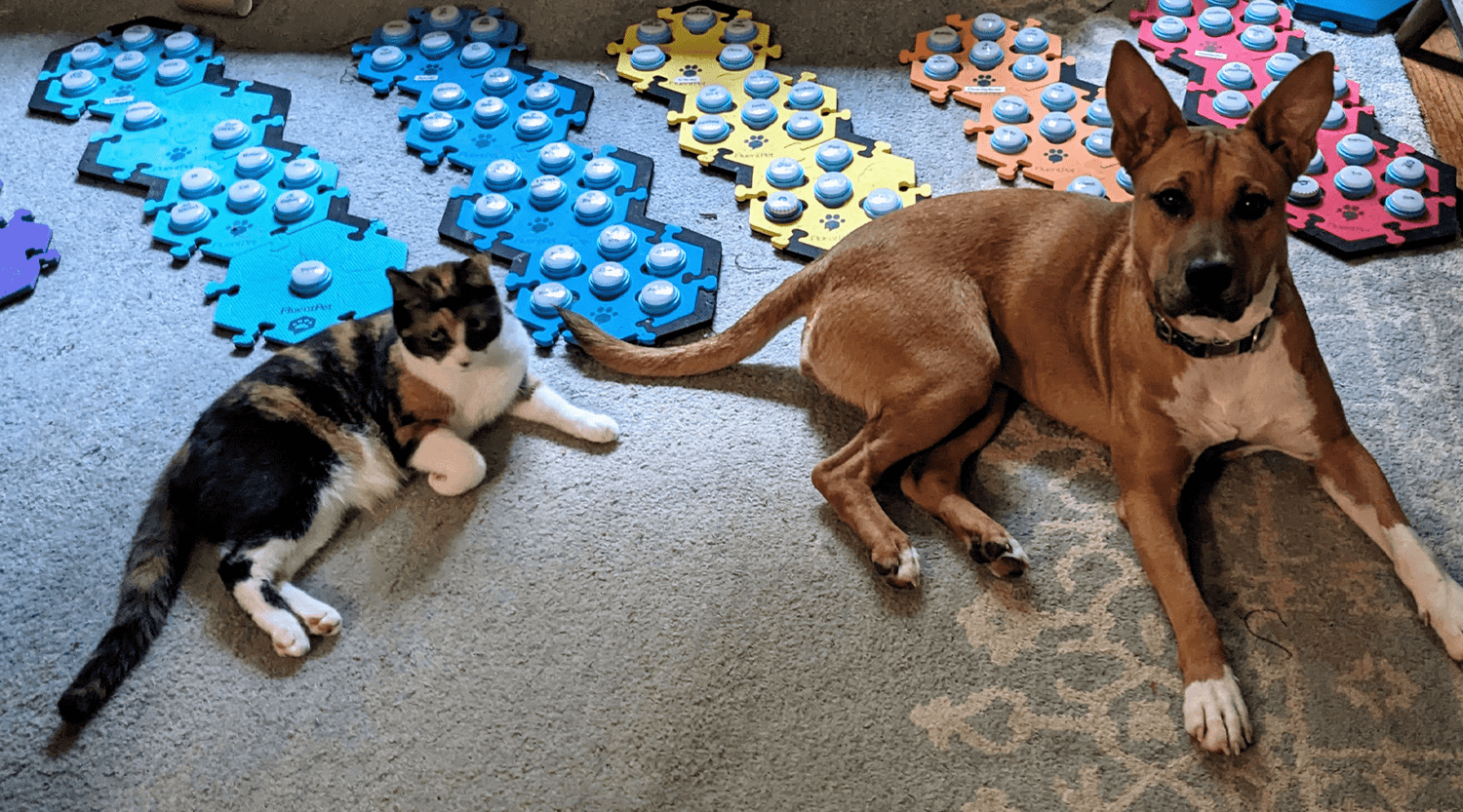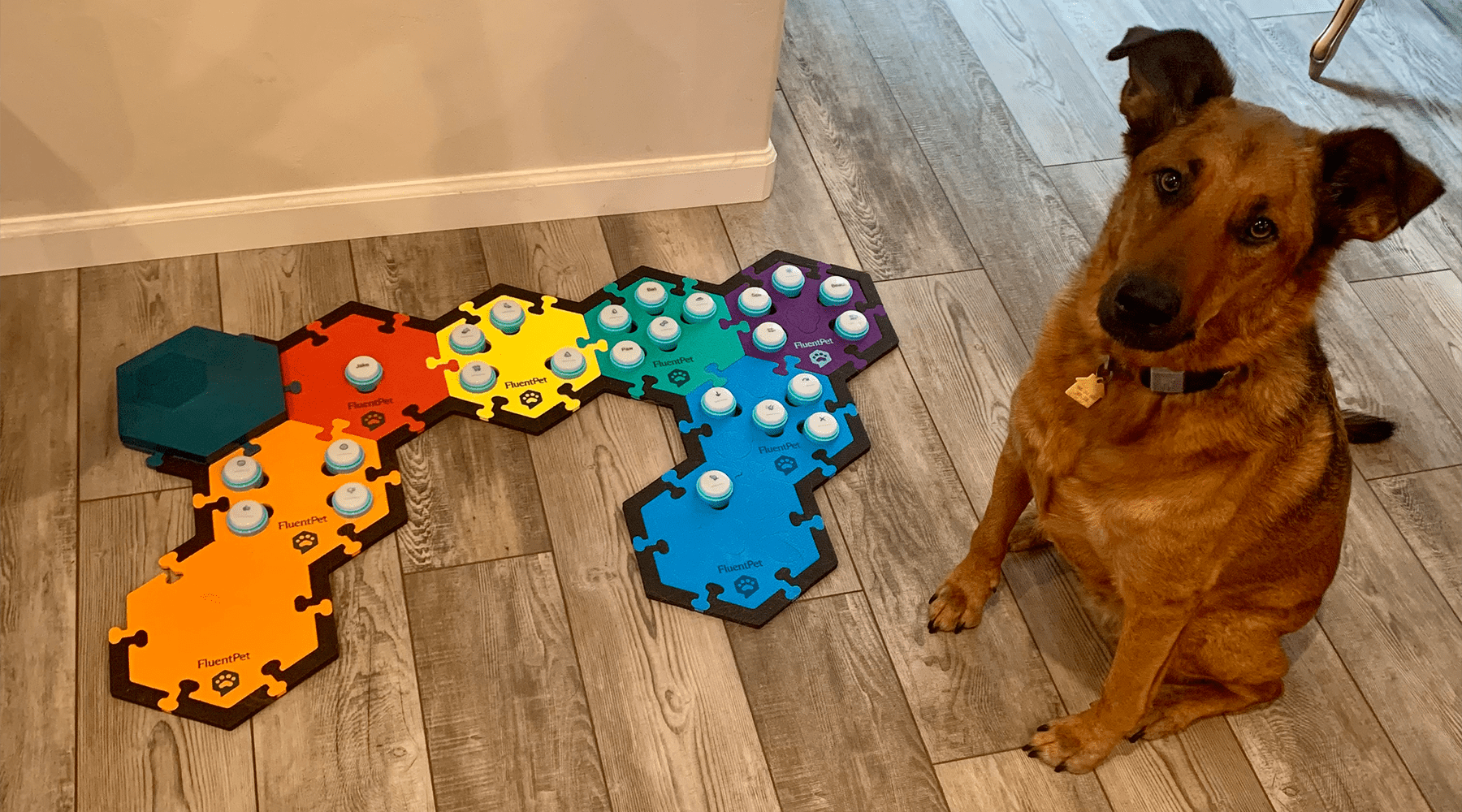Catch Mary Robinette, Elsie, and Guppy in action on Instagram.
Q. So Mary Robinette, who are these learners of yours?

I have two learners, Elsie and Guppy. Elsie is a calico and is both sweet and sassy. She cares about the people around her, but is often full of tortitude about it. She’s six and was not at all happy when Guppy entered our lives. Guppy is a show dog – she just showed up. We found her, starving, by the side of the road and she was originally Guest Puppy. She’s eager, loves everyone, and is very much a What-You-See-Is-What-You-Get sort of dog.
Q. What were your learners' first button?

Elsie’s first button was OPEN. Based on what I’d learned from Elsie, Guppy started with three buttons: TREAT, PLAY, PETS. Play was her favorite.
Q. How long did it take for them to press their first button?

It took Elsie six months to make her first button press. Three years later, she has 124 words. Guppy pressed her first button on day one. A year later and she has seven buttons. She’s a sweet, uncomplicated girl.
Q. What have the buttons revealed about your learners that you wouldn’t have known without the buttons?
 Without buttons, I would not have known that Elsie cared deeply about the people and animals around her. One of the most memorable moments was about my nephew. He had been visiting us for the summer and had recently departed. Cue a thunderstorm. Elsie hates thunderstorms and usually hides under the bed. She came running from the hallway where our nephew’s bedroom was, clearly agitated. She went to her board and said SOON ELI CONCERNED. I told her “Eli gone” and she said WHERE. Without buttons, I would have just thought that she was scared about the storm and not that she was worried about this child being out in the storm.
Without buttons, I would not have known that Elsie cared deeply about the people and animals around her. One of the most memorable moments was about my nephew. He had been visiting us for the summer and had recently departed. Cue a thunderstorm. Elsie hates thunderstorms and usually hides under the bed. She came running from the hallway where our nephew’s bedroom was, clearly agitated. She went to her board and said SOON ELI CONCERNED. I told her “Eli gone” and she said WHERE. Without buttons, I would have just thought that she was scared about the storm and not that she was worried about this child being out in the storm.
Q. What inspired you to do button teaching?
 I’m a writer and was working on a book with talking dragons. I was looking for information about animal language acquisition and stumbled across Christina Hunger and her dog Stella. I was skeptical at first but then I saw Stella combining words for buttons she didn’t have. Then I saw Bunny. And then… Billi the cat and her disdain for Hamilton soundtrack. That was the moment that I decided to try this with Elsie. She had a couple of behavior problems that I knew were related to her being bored – she would climb unsanctioned furniture, bite our ankles, swat us. My hope was just that she would be able to tell us what she wanted to play. That worked and I get a glimpse of her interior life.
I’m a writer and was working on a book with talking dragons. I was looking for information about animal language acquisition and stumbled across Christina Hunger and her dog Stella. I was skeptical at first but then I saw Stella combining words for buttons she didn’t have. Then I saw Bunny. And then… Billi the cat and her disdain for Hamilton soundtrack. That was the moment that I decided to try this with Elsie. She had a couple of behavior problems that I knew were related to her being bored – she would climb unsanctioned furniture, bite our ankles, swat us. My hope was just that she would be able to tell us what she wanted to play. That worked and I get a glimpse of her interior life.
Q. What challenges have you faced with button teaching?
 In hindsight, the first word I chose for Elsie was the wrong one. She already had a clear way to communicate OPEN. She would go to a door, stand on her hind legs, pat the door knob and yell at us. Why should she try this other thing? Added to that, she’s tiny. So I wound up taping the button and tile to the door where her foot naturally landed. That meant she was putting enough pressure on it to trigger it. From there, I lowered it to the floor slowly and we were off.
In hindsight, the first word I chose for Elsie was the wrong one. She already had a clear way to communicate OPEN. She would go to a door, stand on her hind legs, pat the door knob and yell at us. Why should she try this other thing? Added to that, she’s tiny. So I wound up taping the button and tile to the door where her foot naturally landed. That meant she was putting enough pressure on it to trigger it. From there, I lowered it to the floor slowly and we were off.
Q. What’s your funniest button moment?
 There are so many, but one just happened today. We were trying to get a photo of me, Guppy, and Elsie to go with this. The entire time we were taking the photo, Elsie was repeatedly pressing the word BORED.
There are so many, but one just happened today. We were trying to get a photo of me, Guppy, and Elsie to go with this. The entire time we were taking the photo, Elsie was repeatedly pressing the word BORED.
Q. What’s your most surprising button moment?

Elsie likes wearing clothes! I know. We usually think about cats as falling over when they have anything on. I’d given Elsie the word COAT so she could use it for a harness or a sweater. To my complete surprise, she asks for COAT regularly when it’s cold. That led to a very bittersweet moment. A year after Elsie’s companion cat, Helix, passed, Elsie asked for COAT. I always give her two choices and she boops the one she wants. One of her options this time was Helix’s coat. Elsie sniffed it, went to the button board and pressed SMELL HELIX and then jumped up into his old bed.
Q. What’s your favorite button moment?
 When my nephew was staying with us, Elsie gave him the nickname MOUSE so I decided to add a button to the board with his name. As I was recording it, she went to the board and asked, WHAT STRANGER SCRITCHES? In other words, “Who is the person who was just petting me?” I used my nephew’s new button to tell her that his name was Eli. Elsie immediately said, HI ELI. My favorite one with Guppy just happened. I gave her the word FRIEND this week. She pressed it for the first time and then came bounding over to me and wiggled into my lap, licking my face. It’s one thing to know that your learner loves you, it’s another to have them take the extra step of actually saying it.
When my nephew was staying with us, Elsie gave him the nickname MOUSE so I decided to add a button to the board with his name. As I was recording it, she went to the board and asked, WHAT STRANGER SCRITCHES? In other words, “Who is the person who was just petting me?” I used my nephew’s new button to tell her that his name was Eli. Elsie immediately said, HI ELI. My favorite one with Guppy just happened. I gave her the word FRIEND this week. She pressed it for the first time and then came bounding over to me and wiggled into my lap, licking my face. It’s one thing to know that your learner loves you, it’s another to have them take the extra step of actually saying it.
Q. How have buttons changed your relationship with your learner?
 Even though their vocabulary levels are vastly different and probably always will be, I’ve given them both an agency that none of the other pets in my life have had. They aren’t speaking English, but having just a few words of shared language mean that they can be so much more specific about what they want. Guppy can combine PLAY TREAT to mean “I want training” versus PLAY OUTSIDE to ask me to go out and play with her. They are less frustrated. And with Elsie, my ankles are much healthier!
Even though their vocabulary levels are vastly different and probably always will be, I’ve given them both an agency that none of the other pets in my life have had. They aren’t speaking English, but having just a few words of shared language mean that they can be so much more specific about what they want. Guppy can combine PLAY TREAT to mean “I want training” versus PLAY OUTSIDE to ask me to go out and play with her. They are less frustrated. And with Elsie, my ankles are much healthier!
Q. What advice would you give to others who are interested in teaching their learners to use buttons?

Be patient. Imagine that your learner is an ESL toddler who is also an alien.
Q. How did you go about teaching your learner to press their first button?
 With Guppy, I had learned a lot from the community and from the mistakes I made with Elsie. I immediately did target training with her to teach her to press a button. I gave her the word TREAT instead of a nonsense word, because I’d learned two things from Elsie who did not get food words until much later.
With Guppy, I had learned a lot from the community and from the mistakes I made with Elsie. I immediately did target training with her to teach her to press a button. I gave her the word TREAT instead of a nonsense word, because I’d learned two things from Elsie who did not get food words until much later.
- She turned every word into a food word. OPEN that jar for me. TRAINING give me kibble.
- When she had food words, she spammed them for a little bit, and then as soon as she understood that she had control, she stopped in favor of words that were interactive.
As soon as Guppy demonstrated that she knew how to press the button, I added two tiles with PETS and PLAY. From there, it’s all been modeling.
Q. How did you address challenges you faced?
 Either by backing up and simplifying or just giving more time. I find that if I count to 40 in my head, that it gives them time to think.
Either by backing up and simplifying or just giving more time. I find that if I count to 40 in my head, that it gives them time to think.







Leave a comment
This site is protected by hCaptcha and the hCaptcha Privacy Policy and Terms of Service apply.